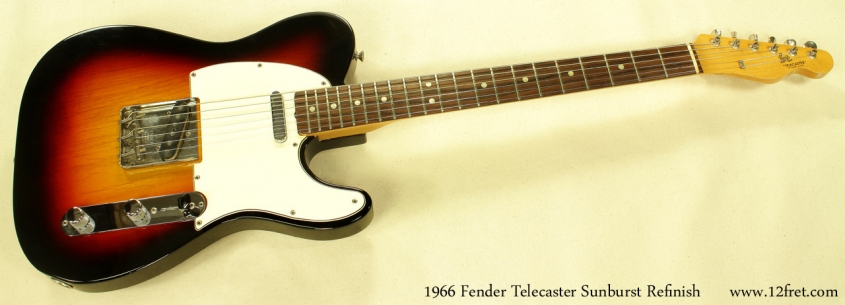| Comments | The Twelfth Fret opened its doors in 1976 at 920 Kingston Road in Toronto’s east end. From the first, we specialized in repairing and restoring guitars for working musicians. One of the services we offered was custom lacquer refinishing, and the body of this 1966 Sunburst Fender Telecaster was refinished in our shop in the late 1970’s (in fact, it’s very likely that I personally did this finish).
Custom refinishing was very popular for some time, though for a number of reasons it is a lot less common now. The refinishing process is extremely labour-intensive, messy and dusty, and ultimately uses a fair number of toxic, unstable substances. This makes it slow, expensive and hazardous. With the purchase by CBS, Fender had new investment that was focused on improving efficiency, lowering costs and increasing production. In 1968, Fender shifted to a new finishing process involving spraying no more than two coats of polyurethane (AUC, or Aliphatic Urethane Coating)rather than many coats of lacquer with wet sanding between coats. This resulted in an incredible reduction in the work (and expense) required for finishing. However, the poly AUC coating is *very* hard and does not react to normal finish strippers. Removing it for the purpose of refinishing requires scraping, sanding or burning(!) it off. Removal of the poly AUC often results in inadvertent changes to the level of the wood surface and the rounded contours – it’s hard to avoid this because of the difference in hardness between the wood and the poly AUC finish. Now, we recommenend that good-condition poly finishes be left on, and used as base coats though they must be cleaned and prepped thoroughly to avoid adhesion problems from oil, wax and cleaner contamination. Alternately, obtaining a replacement body that already has the desired finish can be a cost effective and much faster way of dealing with the refinish request. This particular instrument was originally finished in lacquer, so standard strippers did work, and not so much sanding had to be done. However, this does not look like a factory Fender finish for a couple of reasons. First, it was our practice to prepare the bare wood surface to a much higher degree than had been done at the factory. Factory finish sanding seldom involves more than 220-grit sandpaper. We would keep going and stop at the highest grades we could get, 1200 or 1600 grit. The result of this extra attention is that the wood has much more of a ‘glow’ and the final finish has a perceived sense of natural ‘depth’ that can’t be obtained without this kind of preparation. Second, for the colour coats, we tinted clear lacquer with toner, or NGR (non-grain-raising) stain, and the result can be very translucent and provide many subtle shadings during the sunburst colour transitions. This Telecaster is in good playing condition, and it looks like it wasn’t played much after the refinish, but certainly was played heavily before! It rings out clearly and cleanly with lots of sustain and articulation. |
| Serial Number | 158917, built during 1966 in Fullerton, California. This is an early CBS-period instrument with the F logo neckplate. |
| Pricing | $3899.00 CAD with original case. REDUCED |
| Neck | Maple neck with rosewood fingerboard and original finish. There is a dent in the fingerboard around the 6th fret. Half the decal and most of the word Fender – is missing. Finish on the neck is in good condition otherwise, with some wear in the usual play spots such as the treble side first position. |
| Frets | Original frets. Fender used wider fretwire in some short periods due to material shortages. The frets have significant playing wear but still play cleanly. |
| Body | Alder body showing the tell-tale dowel marks from the Fender factory routing jigs. The bodies were screwed into a jig, and once the routs were done, the screw holes were dowelled and the bodies headed to finishing. |
| Finish | Sunburst nitrocellulose lacquer finish in very good condition. This guitar was originally sunburst, and was refinished close to the late 1970’s at The Twelfth Fret. In fact, it’s very likely that I personally refinished this guitar. The neck finish is original and in good condition, with half the decal missing. |
| Hardware/electronics | Many original components – original Kluson Deluxe Split shaft tuners, original neckplate, bridge and threaded-bar saddles. The neck pickup was recently rewound at The Twelfth Fret by Douglas Harrison. Late pre-CBS crossover knobs. |
| Playability/Action | This guitar plays quite well. And being a Telecaster, the action is completely adjustable from neck angle to saddle height. |
| Case | Original Fender case included. |
You can preview our videos now on Our YouTube Channel!
You can now Visit our Facebook page!







